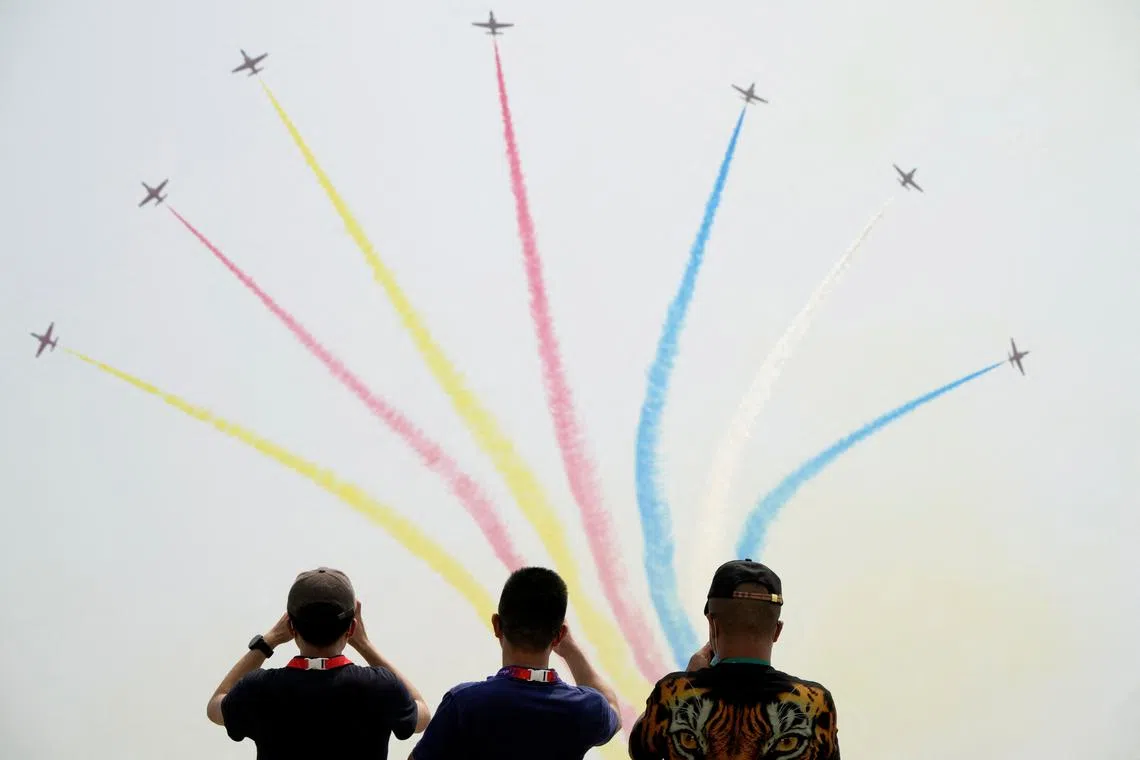New Chinese stealth fighter to take centre stage at China’s biggest air show
Sign up now: Get ST's newsletters delivered to your inbox

People watching a performance by the Chinese People's Liberation Army Air Force Red Falcon aerobatic team in Zhuhai, Guangdong province, in September 2021.
PHOTO: REUTERS
Follow topic:
BEIJING - China's new J-35A stealth fighter jet will be displayed for the first time next week at the country's biggest civil and military air show, a biennial event where Beijing showcases its expanding aerospace industry.
The six-day China International Aviation and Aerospace Exhibition begins on Nov 12 in the southern Greater Bay city of Zhuhai. The 2022 edition of the event led to about US$40 billion (S$52 billion) in "cooperation agreements" being signed, according to its organisers.
Developing domestic aerospace design and manufacturing capabilities is a major strategic priority for Beijing as it vies for regional military dominance with the US amid escalating tensions around Taiwan
China also seeks to reduce its reliance on foreign imports, a concern borne out after Donald Trump won the US presidential election.
Alongside drones, weapons systems, aircraft and electronic warfare technologies, China's emerging role as a commercial airliner manufacturer through state-owned planemaker Comac will be on display.
As the expected highlight of the show, the People's Liberation Army Air Force (PLAAF) will reveal to the public the Shenyang Aircraft Corporation's J-35A, which the air force last week described as a "medium-sized stealth multi-purpose fighter".
Russia has also flown its most advanced fighter jet, the SU-57, to Zhuhai for its first air show abroad, in an apparent message to the West about China-Russia cooperation.
The J-35A, which uses airstrips to take off and land, is a variant of the J-35, a stealthy aircraft China is developing for use on aircraft carriers. Little is known about its performance or capabilities, although it superficially resembles the Lockheed Martin F-35.
The J-35 programme is a follow-on from China's J-31 fighter, which made its public debut at the Zhuhai show in 2014 but was never used by the People's Liberation Army or sold to foreign customers.
Diplomats and security analysts have closely watched the evolution of J-35 variants given the importance of the plane to China's aircraft carrier programme, which seeks to expand jets' range and payload to project power beyond China's home waters.
Nov 11 marks the 75th anniversary of the PLAAF, which will have its largest presence at the air show, Xinhua news agency has reported.
The Zhuhai air show in 2024 is its first post-pandemic edition since Beijing lifted its zero-Covid policy and travel restrictions in 2023.
Airbus and the world's third-largest planemaker, Embraer, will have a presence at the show, but Boeing will not be officially represented after new chief executive Kelly Ortberg halted travel to industry events as the troubled US manufacturer recovers from a damaging seven-week workers' strike that ended this week.
Beijing has invested heavily in developing home-grown commercial planes, and engines that one day may replace the foreign versions that currently power Comac's jets.
Comac-watchers will, in particular, be paying attention to a possible re-branding of the company's ARJ21 regional jet, after one was spotted by aviation enthusiasts in mid-October at a Chinese airport with C909 painted on its blue tail, instead of ARJ21.
Although largely symbolic, the change – which would align with the manufacturer's naming convention for its other models – signals Beijing's growing intention to present itself as a full-scale alternative to Airbus and Boeing, which are both struggling to keep up with demand.
Industry sources say Comac is a long way off from making inroads internationally without benchmark certifications from the EU – which Comac is pursuing for its C919 airliner – or the US.
In particular, competing with Western engines poses one of the most daunting challenges for China's rising aerospace industry, even after a spate of industrial problems in the West.
Even so, Chinese manufacturers will benefit from the sheer scale of their domestic market, analysts say. China is the world's second-largest domestic aviation market after the US.
Boeing has said China will more than double its commercial airplane fleet and need 8,830 new planes by 2043. REUTERS

